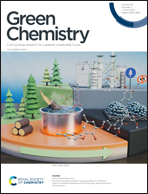1,3-Dioxolane compounds (DOXs) as biobased reaction media†
Abstract
Solvents constitute around 80% of the total volume of chemicals used in fine-chemical processes and contribute significantly to their environmental impact and hazard profile. Thus, there is a strong driving force towards the replacement of traditional fossil-based solvents by alternatives that are more benign in terms of their origin, availability, convenience of synthesis, handling, biodegradability and environmental impact. In the class of polar aprotic solvents, the most successful “green” replacement is γ-valerolactone (GVL). Here, we propose the use of a structurally related compound, 5-methyl-1,3-dioxolane-4-one (LA-H,H), as a reaction medium. It is easily prepared from lactic acid and formaldehyde and satisfies the criteria for a green solvent. It is stable under neutral or basic conditions. Despite the presence of a ketal functionality, it even survives mildly acidic conditions. Evaluation of the Kamlet–Taft and Hansen solvent parameters shows that indeed LA-H,H and GVL are closely similar, suggesting that LA-H,H is an effective new green entry in the class of polar aprotic solvents. We have tested its performance in Pd-catalyzed Heck arylation of methyl acrylate and in the Menschutkin reaction of N-methylimidazole with 1-iodobutane. LA-H,H is also the parent of a whole family of potential solvents easily prepared from two green precursors: α-hydroxy carboxylic acids (lactic, mandelic, and α-hydroxyisobutyric acids) and aldehydes/ketones (formaldehyde, acetaldehyde, and acetone); five such variations were briefly examined. Interestingly, LA-H,H has the unusual property of forming a three-phase system when combined with water and hexane, which may allow technological variations that are not possible with the more normal one- and two-phase systems. As a curiosity, a rare four-phase system is achievable combining LA-H,H with octane, water and perfluorodecaline.



 Please wait while we load your content...
Please wait while we load your content...